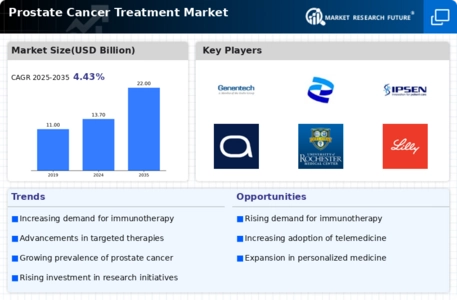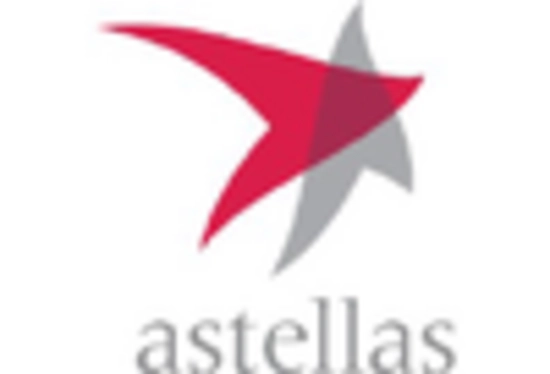Rising Incidence of Prostate Cancer
The increasing incidence of prostate cancer is a primary driver of the Prostate Cancer Treatment Market. Statistics indicate that prostate cancer is one of the most commonly diagnosed cancers among men, with millions of new cases reported annually. This rising trend is attributed to factors such as aging populations and lifestyle changes. As awareness of prostate cancer grows, more men are seeking screening and treatment options, thereby expanding the market. The demand for effective treatment modalities, including surgery, radiation therapy, and hormone therapy, is likely to increase as the number of diagnosed cases rises. Consequently, healthcare providers are focusing on developing innovative treatment solutions to cater to this growing patient population, which is expected to further propel the Prostate Cancer Treatment Market.
Growing Awareness and Screening Programs
Growing awareness and screening programs are pivotal in shaping the Prostate Cancer Treatment Market. Educational campaigns aimed at increasing knowledge about prostate cancer symptoms and the importance of early detection are encouraging more men to undergo screening. Initiatives by healthcare organizations and advocacy groups are instrumental in promoting prostate-specific antigen (PSA) testing, which aids in the early diagnosis of the disease. As more individuals become aware of the risks associated with prostate cancer, the demand for diagnostic and treatment services is likely to rise. This heightened awareness not only leads to earlier interventions but also fosters a more proactive approach to managing prostate health. Consequently, the Prostate Cancer Treatment Market is expected to benefit from the increased patient engagement and subsequent treatment uptake.
Increasing Investment in Cancer Research
The increasing investment in cancer research is a crucial driver for the Prostate Cancer Treatment Market. Governments and private organizations are allocating significant funds to research initiatives aimed at understanding prostate cancer biology and developing novel therapies. This influx of funding is facilitating clinical trials for new drugs and treatment approaches, which are essential for advancing care. For example, recent studies have focused on the genetic underpinnings of prostate cancer, leading to the identification of potential biomarkers for targeted therapies. As research progresses, the introduction of innovative treatment options is expected to enhance patient outcomes and drive market growth. The commitment to cancer research underscores the importance of addressing prostate cancer, thereby positively impacting the Prostate Cancer Treatment Market.
Aging Population and Changing Demographics
The aging population and changing demographics are significant factors driving the Prostate Cancer Treatment Market. As life expectancy increases, a larger segment of the population is entering the age bracket most susceptible to prostate cancer, typically men over 50. This demographic shift is likely to result in a higher incidence of prostate cancer diagnoses, thereby increasing the demand for treatment options. Additionally, the growing diversity in populations may lead to variations in prostate cancer prevalence and treatment responses, necessitating tailored approaches to care. Healthcare systems are adapting to these demographic changes by enhancing their treatment offerings and ensuring accessibility to care. As a result, the Prostate Cancer Treatment Market is poised for growth, driven by the need to address the unique challenges posed by an aging and diverse population.
Technological Advancements in Treatment Modalities
Technological advancements in treatment modalities are significantly influencing the Prostate Cancer Treatment Market. Innovations such as robotic-assisted surgeries, advanced radiation techniques, and novel drug formulations are enhancing treatment efficacy and patient outcomes. For instance, the introduction of high-precision radiation therapies, like stereotactic body radiation therapy (SBRT), has shown promising results in reducing side effects while improving tumor control rates. Furthermore, the development of new pharmacological agents, including targeted therapies and immunotherapies, is expanding the treatment landscape. These advancements not only improve survival rates but also enhance the quality of life for patients. As technology continues to evolve, it is anticipated that the Prostate Cancer Treatment Market will experience substantial growth driven by these cutting-edge treatment options.


















Leave a Comment